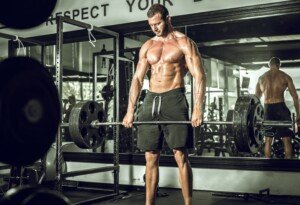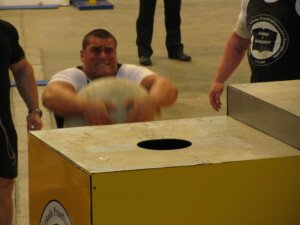
Learn why it’s a myth that lifting weights is harder for tall people.
It’s often said that tall people have a harder time with lifting weights, and that it’s easier for short athletes.
Let’s assume that it truly is, collectively, more difficult for tall people to lift weights.
Does this mean that it’s harder for a healthy 5’7 man to strength train than it is for a healthy 5’2 man?
After all, the first person is a lot taller.
Is the tallness relative, or is it absolute, when it comes to lifting weights?
Let’s assume it’s an absolute issue, that is, those over 6’3 have a hard time lifting heavy weights.
Take a look at any strongman competition. Note the heights of the athletes.

Though many of the events favor extreme height, such as the Atlas stone (above) and the fingal’s finger, what really stands out is that even the tallest of these athletes (e.g., Mike Jenkins at 6’6 and Brian Shaw at 6’8) are built with massive amounts of muscle.
This means these very tall men have been able to lift super heavy weight loads in the gym as part of their training.
Their significant muscle mass didn’t come from just eating two pounds of chicken every day.
A classic argument is that weightlifting is more difficult for tall people because they have a greater range of motion through which to move the resistance.
The flaw with this thinking is that, along with the greater range of motion, is a longer body, with longer limb segments. It’s all relative.
The 5’7 man may seem to have a small range of motion for the bench press because the distance that he creates through the air, from when his arms are bent to when they’re straightened, is shorter than that created by a 6’5 man.
However, this distance is within the context of what their arms are attached to: chest/shoulders.
To make this easier to understand, imagine you’re sitting several feet behind a man who’s bench pressing, so that the top of his head is facing you.
Imagine that person is six feet even. Now imagine his arms are the same length as those of a typical five-foot person.
Imagine him bench pressing with these super short arms attached to his chest and shoulders. What happens?
By the time the bar gets down to that man’s chest, his upper arms are still way LESS than parallel to the floor. The angle that’s created by his elbow flexion is quite large.
The range with which he must press the weight back up, once it’s lowered, is minimized, because the “bottom” of the movement has his elbow flexion minimized, due to such relatively short arms.
Now picture a five foot tall man with six foot long arms. Imagine him lowering that bar to his chest.
In order to get the bar to his chest, he must execute extreme elbow flexion, such that when the bar is at his chest, his upper arms are way PAST parallel; his elbows are forming a very acute (much less than 90 degree) angle.
From your point of view, sitting several feet behind him, you see extremely bent arms, elbows poking towards the floor.
To push the weight back up, this person must begin the movement with very bent arms, elbows below the level of the bench, even.
That’s a lot of space through which to push the weight. It will thus be much more difficult.
Do you now see what’s really going on here?
It’s not absolute overall body height that’s the issue when it comes to lifting weights.
It’s limb length relative to one’s height.
A short person with “gorilla arms” will have a harder time benching heavy weight than will a very tall person with the so-called T-rex arms.
However, the tall person with the T-rex arms will be at a disadvantage when it comes to picking heavy objects off the floor; he’ll have to bend over way more or squat deeper to reach the object: a greater range of motion.
There are mighty strong tall people, and mighty strong short people.
Certain sports favor certain body proportions, regardless of height, while other sports favor being very tall (swimming) in combination with proportions (e.g., Michael Phelps).
On the other hand, with his ridiculously short legs and abnormally long torso, Phelps probably could never have excelled at skiing.
Being tall, in and of itself, does not make it harder to lift weights.


























